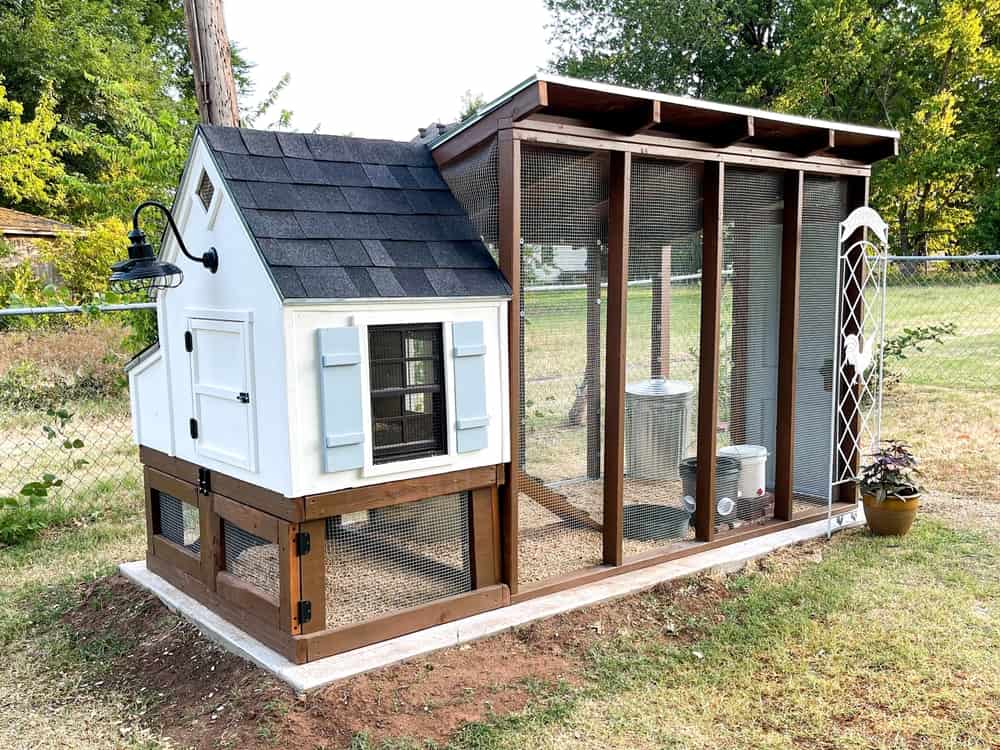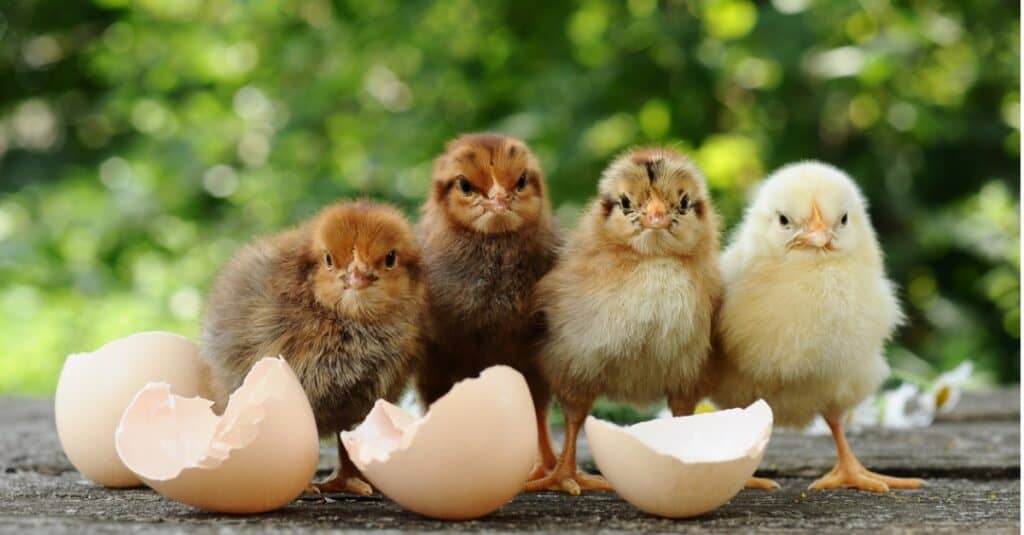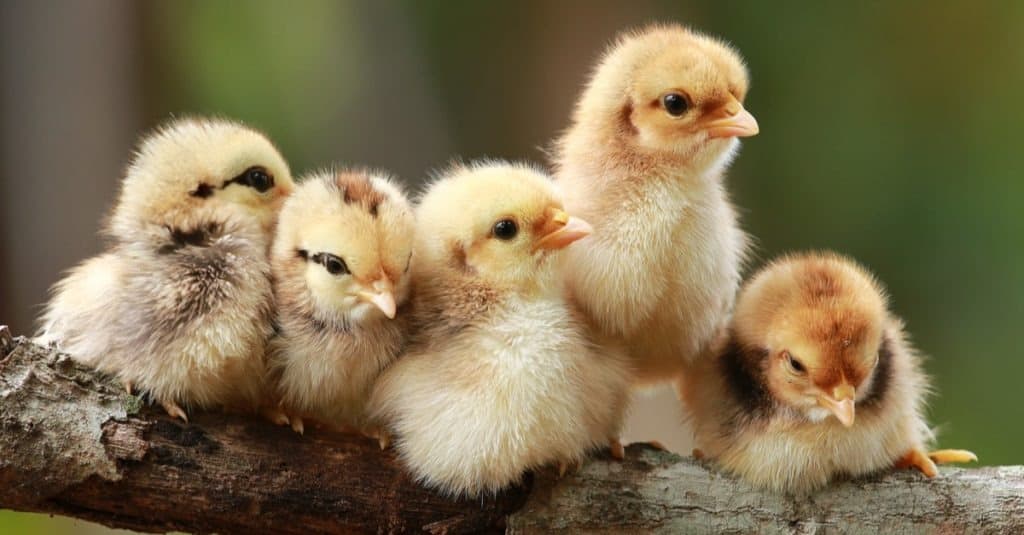How do you know when it’s time to transition chickens from brooder to coop? And what can you do to ensure a smooth transition? Those questions don’t have a simple answer, but by understanding the factors involved, you can determine the answers for yourself.
When Is the Best Time?

A coop with a secure run attached is perfect for a small backyard flock.
©Courtney Jenckes/Shutterstock.com
You can determine the best time to move your chicks to the coop by considering several factors: the weather, feathering, features of your coop, and how many chicks you have.
Age

Until chicks have feathers, they require a brooder to keep warm.
©iStock.com/OlgaVolodina
The age of your chicks will determine how much feathering they have. Adequate feathering is critical when you move chicks from a brooder to a coop because feathers are what help chickens regulate their temperature.
In most cases, a chicken is almost fully feathered by six weeks old and is usually considered ready to live in a coop, but this will vary slightly by breed. Sometimes it’s okay to move your birds before the six-week mark if other conditions are met, and they appear to be fully feathered. Conversely, there are also instances when waiting a couple more weeks before transitioning your chickens to their new home is better.
Weather

Adult chickens do just fine in the snow and don’t usually need supplemental heat.
©Amy Kerkemeyer/Shutterstock.com
From the time they hatch, chicks can handle temperature drops of five degrees each week until the brooder’s temperature is about the same as the ambient temperature in the coop, as long as it isn’t too cold and outdoor temperatures aren’t below 70 degrees Fahrenheit.
In hot climates, you can move your chickens before the six-week marker if they are feathered out and kept in a secure space without other birds. However, they will still need supplemental heat if temperatures fall below 75 degrees Fahrenheit.
You may be better served in cold weather by waiting beyond six weeks to transition your chickens. By waiting for them to reach eight weeks old, your chickens will be stronger and better able to handle cold temperatures. If you must move your birds in cold weather when they are six weeks old, ensure that you can safely offer supplemental heat so they can get warm if needed.
Coop Factors

Ensure your coop is predator-proof.
©Cynthia Farmer/Shutterstock.com
Your coop must be secure from predators, including snakes that can get through very small spaces. Likewise, your chicken run should be just as secure, not only to keep predators out but to keep smaller birds in. If your coop and run are not completely secure, you should not move your young birds until it is ready.
Another factor to consider is if your coop has electricity. If there’s a chance that your birds will need extra heat, you’ll need electricity to provide it. If you aren’t able to do that, you should wait to move them.
Number of Chicks

Chickens often huddle together for warmth.
©PCHT/Shutterstock.com
Have you ever wondered why hatcheries require that you purchase a minimum number of chicks? Part of the reason is warmth. The more chicks that are huddled together, the warmer they will be.
This same logic holds true when you move them to the coop. If you only have two or three chickens, they may not generate enough heat to stay warm, so you’ll need to wait to move them until they are bigger or the temperatures are warmer. If you have ten chickens, they will create more heat, resulting in a warmer coop. In this case, you should be able to move them at around six weeks old.
6 Tips for a Successful Transition from Brooder to Coop

A group of baby chicks eating chicken feed in a brooder on a farm.
©iStock.com/Jennifer Chamblee
1. Protect Younger Birds
Do you have other chickens in your coop already? If you do, ensure your new chickens are large enough to defend themselves in case the older birds become aggressive. It’s called a “pecking order” for a reason. Older, more dominant birds will peck younger ones to assert dominance. If a bird is very small, it could get injured or even killed.
2. Allow Gradual Introductions
Allow gradual introductions if you are introducing new birds to your flock. Consider using a cage or gate to separate new birds from older birds. This will allow them time to get to know each other safely.
3. Provide a Place to Hide
New additions to your flock will be fearful when placed in the coop. Provide places for them to hide when they get scared, including places that are too small for any older chickens to access so the younger ones can escape bullying if necessary.
4. Ensure Food and Water Is Easy to Access
Often, people will suspend their feeders and water in order to help keep them clean. Young chickens may be unable to reach suspended feeders, so ensure there is plenty of fresh water and food in an easy-to-access location.
5. Keep Them Inside
When birds are first introduced to the coop, they do not know this is home. It’s best to keep them confined to the coop for several weeks until they fully adjust to their new environment and know to return here at night.
6. Skip Nest Boxes
Do not allow young birds access to nest boxes. Nest boxes look like great places to sleep and can end up being used as a roosting spot instead of a nesting spot. When this happens, keeping them clean is difficult because chickens tend to eliminate during sleep, making the space unsuitable for eggs. You should wait until the chickens are 17 or 18 weeks old before introducing a nest box, and ensure there is plenty of perch space for sleeping birds.
Chickens can be a wonderful addition to your home and are generally easy to care for. By making the transition from brooder to coop an easy one, you’ll give your chickens the best start possible for many years of enjoyment.
The photo featured at the top of this post is © Franziska93/iStock via Getty Images
Thank you for reading! Have some feedback for us? Contact the AZ Animals editorial team.






